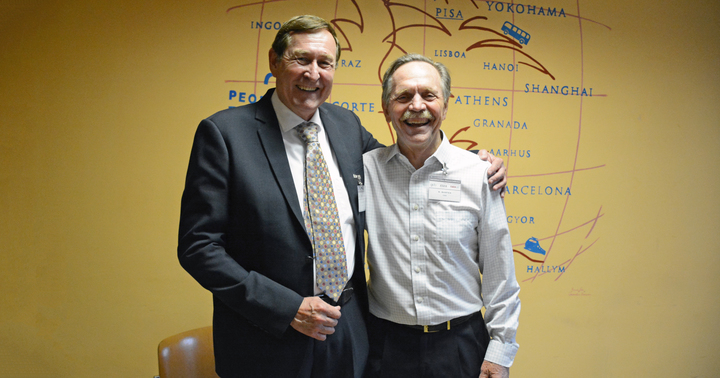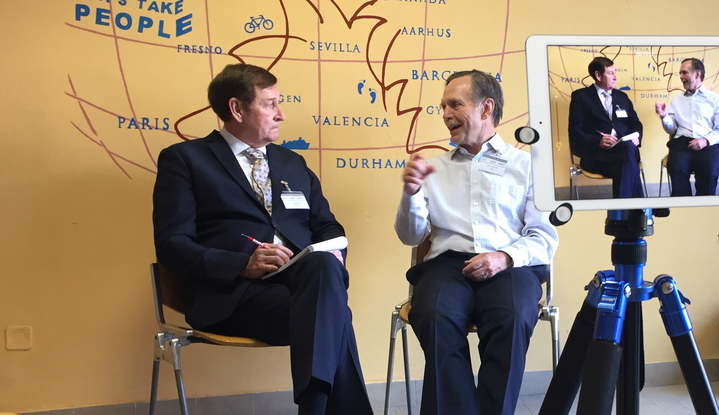#IARC2017 – FARA Rose from a Family’s Pain in Hopes of Helping Others

Ron Bartek has a long list of accomplishments.
He was a West Point graduate and U.S. Army officer, worked on U.S.-Soviet nuclear arms reduction treaties for the State Department in the 1980s, was a congressional staff member, and ran his own public affairs company.
But if you ask what his greatest accomplishment is, he’ll likely say co-founding the Friedreich’s Ataxia Research Foundation — or FARA — with his wife Rachel in 1998.
It’s a heart-rending story. The couple’s son Keith was diagnosed with Friedreich’s ataxia (FA), the most common of the 100 or so ataxias, when he was 11 years old. He died of the heart complications that FA generates when he was only 24.
Bartek spoke with Friedreich’s Ataxia News about FARA’s founding and what appears to be the rising prospects for therapy breakthroughs on the sidelines of IARC 2017, the International Ataxia Research Conference taking place in Pisa, Italy, now through Sept. 30. (A video of the interview runs below this article.)
FARA has raised millions of dollars in the past two decades for basic science and therapy-development research on FA. Meanwhile, a dozen similar organizations have surfaced in other countries.
These groups include Ataxia UK and Italy’s GoFAR, which, along with FARA, are the IARC conference’s main organizers.
FARA’s commitment to research, like that of the other groups, has led to the drug development effort reaching a critical mass that Bartek believes will soon lead to the first approved treatments for Friedreich’s ataxia.
One reason for his optimism is that a lot more scientists and pharmaceutical companies have jumped into the therapy development effort in the past decade, he said.
When the couple founded FARA, only three scientists and no companies were doing ataxia research, he said.
Now, he said, dozens of researchers are working on Friedreich’s ataxia and the 100 or so other ataxias. And 30 to 35 companies are trying to develop ataxia treatments.
Those companies have held about 10 clinical trials of potential therapies, and are in the midst of conducting about 10 more, Bartek said.
The Barteks started FARA as volunteers, with the board consisting of themselves, one Friedreich’s ataxia patient, six members of other families whose children had FA, and the three scientists they had found who were involved in FA research.
It continued to be a voluntary organization, with members raising funds, putting out newsletters, and handling all other tasks, until 2006.
In its first year, 1998, it raised $100,000 — including $40,000 from the National Institutes of Health — to hold the first international ataxia conference. Most of the funding came from letter-writing campaigns and walk-a-thons.
As more families with ataxia learned about FARA, they also began donating, and this spread to others they knew, widening the circle.
The increase in the resource base led to FARA doubling the amount it raised four years in a row — to $800,000 in the fourth year.
Adding a gala ball in Tampa to the mix sent fund-raising to another level. Last year, FARA raised $6 million. This year’s seventh version of that gala, held just days after Hurricane Irma passed by, generated $2 million alone.
Bartek said the Pisa conference comes against a backdrop of new treatment strategies that are generating hope in the FA community.
As an example, he said a protein replacement strategy should be in clinical trials soon. FA is caused by a faulty gene that is unable to produce the frataxin protein, which is vital to a number of the body’s functions. Replacing the protein that the abnormal gene is supposed to generate could be a way to counter Friedreich’s ataxia.
“The company [Chondrial Therapeutics] is here at the conference, and its scientists are here,” Bartek said. The therapy it is developing is known as CTI-1601.
Meanwhile, at least four companies and two universities are working on another strategy — gene therapy, he said.
And other researchers are pursuing a gene replacement strategy.
These three approaches basically involve replacing faulty components that lead to ataxia with healthy components.
Some companies have told FARA that they decided on Friedreich’s ataxia for their gene therapy work because of the groundwork that FARA and other organizations had laid.
They “saw how much of the basic work we’ve done, and that FARA and our colleagues had characterized the disease” well, Bartek said.
Other factors that appealed to those companies were FARA having the largest registry of patients with Friedreich’s ataxia, a large FA natural history database, and a large clinical trial network spanning the United States, Canada, Australia and Brazil. Natural history refers to the way a disease develops in a person over time.
Bartek said ataxia experts believe no one therapy approach “will necessarily be curative by themselves.”
“So we’re looking at a cocktail strategy — a combined therapy. I would be surprised if some sort of gene replacement, protein replacement or gene therapy strategy will not be in this final cocktail,” he said.
“We’ll continue to build our pipeline until we get a cure.”
His last memories of his son Keith only strengthened his commitment to a cure.
Keith died of congestive heart failure that claims about 80 percent of patients with FA.
As he was near the end, “he said to me that he was really grateful that we tried to do everything we could to help him,” said Bartek, his voice cracking.
“I know you wanted this to be in time for me,” Keith said. “You didn’t quite make it, but I know you’ll keep going till you get it.”
Then he added: “You will be in time for some of my buddies.”
Taking a moment to compose himself, his father told Friedreich’s Ataxia News: “And that’s what we’re going to do.”
https://www.facebook.com/friedreichsataxianews/videos/1961874183839791/







